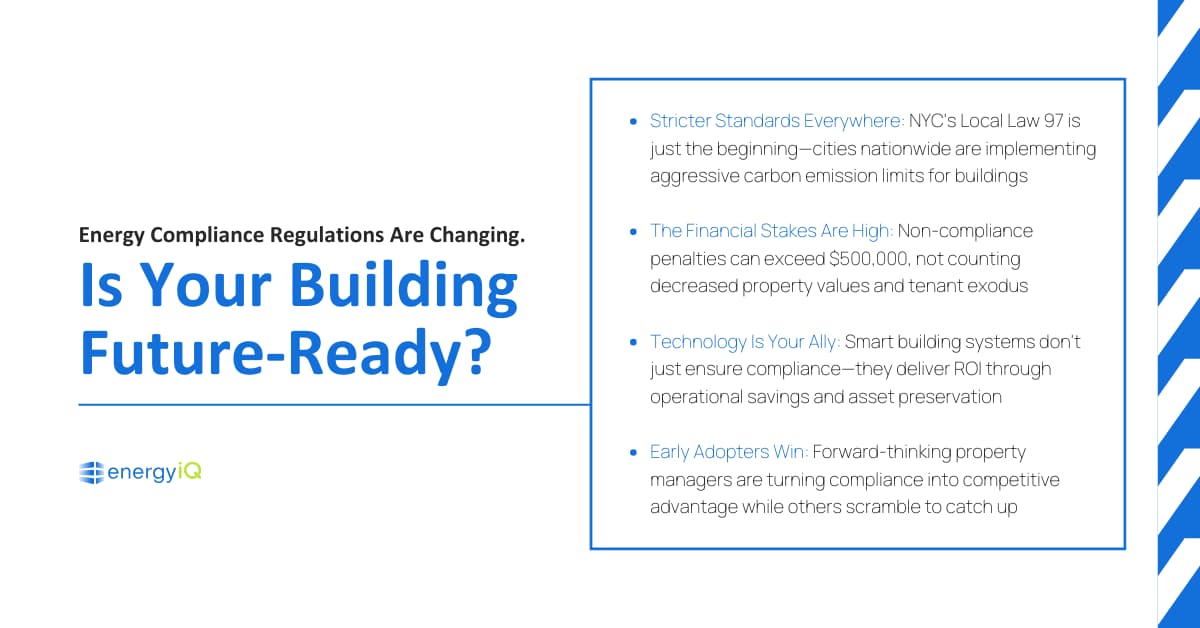The energy landscape is transforming rapidly. Just as technology constantly evolves, energy compliance regulations are becoming increasingly stringent to drive sustainability and efficiency across the built environment. For property owners and facility managers, this shift isn’t just a regulatory hurdle—it’s a fundamental change in how buildings must operate to remain competitive and valuable.
What You Need to Know

The New Reality of Energy Regulations
Energy compliance is no longer an optional checkbox—it’s becoming the foundation of responsible real estate management. New York City’s Local Law 97 represents the vanguard of this transformation, establishing strict carbon emission caps for buildings over 25,000 square feet as part of the city’s ambitious climate goals: 40% emissions reduction by 2030 and 80% by 2050.
This isn’t isolated to New York. A wave of similar regulations is sweeping across the country:
- California’s Building Energy Efficiency Standards are raising the bar for energy performance in new construction and renovations
- Washington D.C.’s Building Energy Performance Standards (BEPS) now require underperforming buildings to implement improvements on a regular cycle
- Boston, Chicago, St. Louis and Seattle have all introduced their own versions of building performance standards
The message is clear: building performance standards are reshaping real estate economics. Regulatory compliance is transitioning from an occasional concern to an ongoing strategic priority that impacts asset valuation and operational decisions.
When Non-Compliance Becomes a Liability
The financial consequences of failing to meet these new standards extend far beyond simple fines. Under NYC’s Local Law 97 alone:
- Missing reporting deadlines: $0.50 per square foot per month (that’s $15,000 monthly for a 30,000 sq ft building)
- Exceeding emissions limits: $268 per excess metric ton of carbon (which adds up quickly for inefficient buildings)
- False statement penalties: Up to $500,000 in severe cases
But direct penalties are just the beginning. The hidden costs of non-compliance are often more damaging:
“Buildings with poor energy performance and compliance issues are becoming increasingly difficult to finance. We’re seeing investors walk away from otherwise attractive properties due to compliance liabilities.” — Commercial Real Estate Analyst
The real-world consequences are already emerging:
- Decreased asset value: Non-compliant buildings face value depreciation as buyers factor in remediation costs
- Tenant flight: Environmentally conscious companies are avoiding buildings with poor energy credentials
- Financing challenges: Lenders are scrutinizing energy performance during underwriting
- Retrofit rush: Property managers who delayed action now face compressed timelines and premium contractor rates
The Power of Automation: From Compliance Burden to Business Advantage
Smart technology has transformed compliance from a paperwork nightmare into a strategic opportunity. Here’s how automation is revolutionizing energy management:
Continuous Optimization vs. Periodic Scrambling
Traditional approaches meant frantic preparation before reporting deadlines. Now, automated systems continuously monitor, adjust, and document energy usage, ensuring you’re always in compliance while maximizing efficiency.
Real-Time Intelligence
Advanced monitoring provides instant visibility into energy consumption patterns across your entire property portfolio:
- Identify anomalies before they become expensive problems
- Document compliance with automatically generated reports
- Prioritize improvements based on actual performance data
- Verify ROI of energy-saving initiatives
AI-Powered Efficiency
The most sophisticated solutions now employ artificial intelligence to drive unprecedented efficiency:
- Predictive algorithms that adjust HVAC operations based on weather forecasts
- Occupancy detection systems that optimize lighting and ventilation
- Automated fault detection that identifies equipment issues before failure
- Energy use forecasting that helps prevent demand charges and peak usage
The result isn’t just compliance—it’s transformative efficiency that delivers substantial operational savings while ensuring your building meets and exceeds regulatory requirements.
Your Strategic Compliance Roadmap
Achieving and maintaining compliance requires a structured approach. Here’s your four-step action plan:
1. Conduct a Comprehensive Energy Audit
Think of an energy audit as your building’s complete physical examination. Professional auditors will:
- Analyze historical energy usage patterns
- Identify inefficient systems and operational practices
- Quantify potential savings opportunities
- Create a prioritized improvement roadmap
An audit provides the baseline data essential for strategic decision-making, helping you focus resources where they’ll deliver the greatest compliance impact and ROI.
2. Implement Smart Building Technologies
Transform your building’s operations with technologies designed specifically for efficiency and compliance:
- Intelligent building management systems that integrate HVAC, lighting, and other systems
- IoT sensors that provide granular usage data and enable zone-specific controls
- Energy analytics platforms that translate complex data into actionable insights
- Automated reporting tools that streamline compliance documentation
These technologies don’t just help meet today’s regulations—they futureproof your building against tomorrow’s even stricter requirements.
3. Leverage Data-Driven Decision Making
The most successful property managers are those who harness the power of their building data:
- Establish KPIs for energy performance across your portfolio
- Create dashboards that highlight compliance status and risks
- Implement regular reporting cycles to track improvement initiatives
- Use benchmarking to compare performance against industry standards
With proper data management, compliance becomes an ongoing process rather than a periodic crisis.
4. Stay Ahead of Regulatory Changes
Regulations will continue to evolve, so maintaining awareness is critical:
- Join industry associations focused on energy policy
- Establish relationships with local regulatory authorities
- Participate in sustainability-focused real estate forums
- Consider engaging compliance consultants who specialize in your market
Proactive awareness allows you to anticipate changes and integrate compliance requirements into your long-term capital planning.
Transform Compliance from Burden to Competitive Edge with EnergyIQ
Energy regulations are becoming more demanding every year, and the cost of falling behind is growing exponentially. Forward-thinking property managers and investors are discovering that the right approach to compliance doesn’t just avoid penalties—it delivers meaningful competitive advantages.
By embracing automation and smart building technologies, you can:
- Simplify compliance with automated monitoring and reporting
- Reduce operational costs through optimized energy management
- Improve tenant satisfaction with better building performance
- Preserve asset value by staying ahead of regulatory requirements
- Generate valuable ESG data for investors and stakeholders
EnergyIQ’s integrated platform combines advanced monitoring, AI-powered optimization, and automated reporting to deliver comprehensive compliance solutions tailored to your specific building portfolio. Our experts understand the complex regulatory landscape and can help transform your approach to energy management.
Don’t just comply with today’s regulations—prepare your buildings for tomorrow’s standards and turn energy management into a strategic advantage.
Ready to future-proof your property portfolio?
Contact EnergyIQ today to schedule a consultation and discover how our smart building solutions can streamline your compliance strategy while maximizing energy efficiency and asset value.



